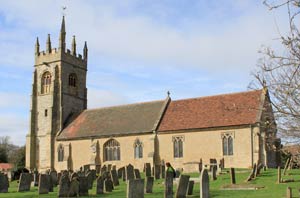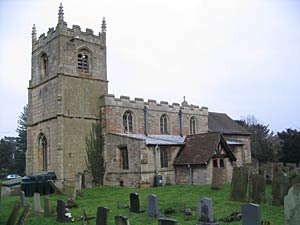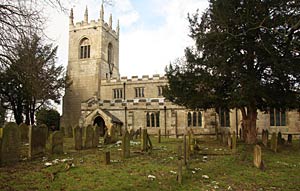< Previous | Contents | Next >
A Diamond for the Crown

Upton church in 2011.
UPTON. It sees from its slope the delightful countryside where the little River Greet runs to the Trent, and it has a fine view of the valley from its churchyard, seeing Lincoln Cathedral on a clear day.
Elms and a great chestnut are among the beautiful trees about the church, whose glory is its splendid 15th century tower. Buttressed to the top, it is crowned with eight pinnacles clustered round a central one, known as the Nine Disciples. Up in the tower is a priest's room with a fireplace, and holes in the walls where doves nested in olden days. It is one of the very few tower dovecots still left in our churches.
Medieval windows fill the church with light. The nave arcade with clustered pillars, the rebuilt chancel arch, and the small arch between the aisle and the shallow transept, are all 13th century. The transept has a tiny peephole, and has been restored in memory often men who died for peace. The 14th century font has been brought back from the churchyard. By the pulpit are fragments of two earthen jars which were used in olden times as amplifiers of sound, the first loud speakers. The greatest possession here is a lovely chest over six feet long, adorned with iron bands and stars with tiny roses and trefoils; it may be 13th century.
Here was born one of a great host of 19th century men who made their way from small beginnings and built up our knowledge of the world. He was James Tennant, who began work at a shop dealing in minerals and shells, and grew up to be Professor of Mineralogy at King's College. He was one of a family of 12, his father an officer of the excise; his mother belonged to a yeoman family living in Upton for two centuries. Young Tennant was able to hear Michael Faraday's lectures at the Royal Institution, and Faraday became his friend. He was one of the first experts to confirm the genuineness of the first diamonds found in South Africa, and he was in charge of the cutting of the Koh-i-nor for Queen Victoria's crown.
The Queer Old Head
WALESBY. It lies in the byways, with Hanging Hill Plantation and the fine mass of Bevercotes Park on one hand, and on the other a pretty spot where the Whitewater flows by willow banks.

Walesby church in 2006.
It is proud of its fine little church with a 15th century tower, and of the glorious trees in the churchyard; two splendid beeches bring us to the door (though one is now only half of its old self), two others are in a majestic row of limes, and there are ancient yews.
Its oldest possessions are a plain Norman doorway and the fine Norman bowl of the font; over the doorway is a modern porch with fragments of 13th century arcading in its walls, used now as a vestry. The north doorway, with part of an ancient coffin stone for a step, opens to an interior filled with light by charming medieval windows. The nave arcade comes from the close of the 13th century, its short arches on tall pillars.
The restored piscina in the 14th century chancel has a strange old head supporting the projecting drain, the face all awry, and resting on the hands of two arms coming from the wall. Over the piscina a small crowned head is wearing away, and on an old bracket in the aisle lies a stone corbel carved with a face. The 17th century pulpit has panels carved with thistles and leaves, and eight oak benches 400 years old have set the pattern for the new ones.
Twentieth Century Craftsmen

Walkeringham church in 2012.
© Copyright Richard Croft and licensed for reuse under this Creative Commons Licence
WALKERINGHAM. It is a mile from the Trent, where the ferry takes us into Lincolnshire. Its all-embattled church, rising from a trim belt of lawn and a bright border of flowers, has the old twin-gabled manor house for company, and close by is a fragment of the old market cross on three great steps.
The church has nothing older than its 13th century nave arcades, the pillars resting on fine square bases made eight-sided at the top. From the 15th century come the tower, the clerestory, and most of the windows, and two arches in the north wall of the chancel. These arches rest on a 13th century pillar, and on their hood are three quaint little heads. An old face peeps unexpectedly from the wall of the north aisle.
Much old timber remains in the roofs; there are three old benches, a Jacobean table, and an elm chest with its original ironwork (over 400 years old) and a new lid. The altar rails are very beautiful with trailing vine and grapes and ears of wheat hanging from the rail, and four splendid poppyheads carved with foliage and partridges among growing corn. We found the vicar and the sexton working here like two medieval craftsmen, adapting the 400-year-old screen to let more light into the chancel; using the upper part to enclose the vestry (where there is other old screenwork), and embodying the 17th century pulpit with the base.
On an elaborate monument kneel Francis Williamson and his wife, he in rich attire, and she in a full-skirted gown and flowing head-dress of Stuart days. Three sons kneel below, and a rhyming epitaph bids us use this monument as a mirror in which to see ourselves:
Then thoughts and cares for long life save,
And be undressing for the grave.
